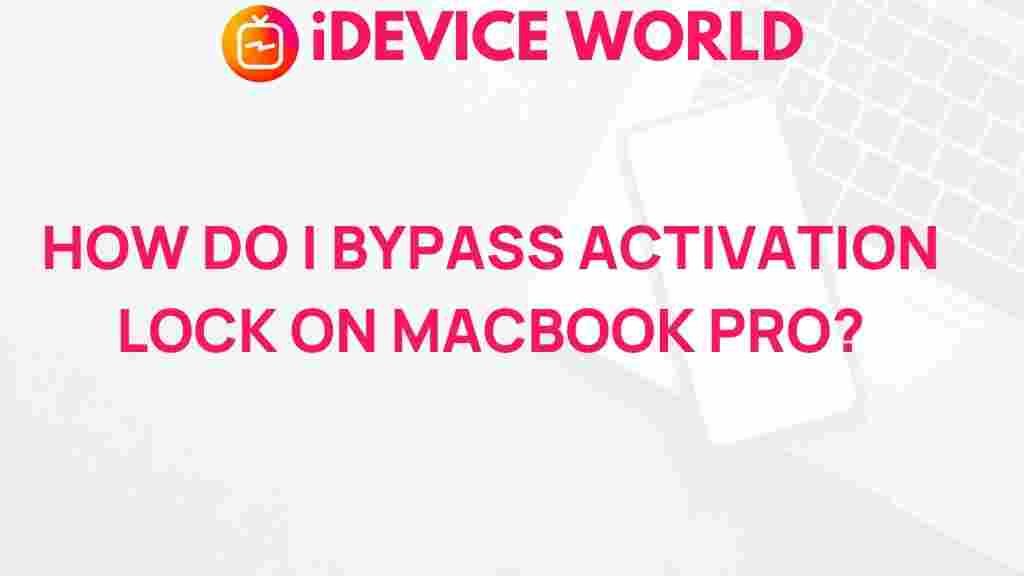Understanding Activation Lock on MacBook Pro
Activation Lock is a security feature on MacBook Pro designed by Apple to protect your device and personal data if it’s lost or stolen. When enabled, it requires the Apple ID and password originally associated with the MacBook to unlock it, making unauthorized access more difficult.
While Activation Lock is a valuable safeguard, there may be legitimate cases where you need to bypass it. For example, if you’ve purchased a secondhand MacBook Pro with Activation Lock enabled and can’t access the previous owner’s account, or if you’re locked out of your own device due to lost credentials. In this guide, we’ll dive into methods to unlock the Activation Lock on your MacBook Pro, provide troubleshooting advice, and help you understand the limitations and risks involved.
Steps to Bypass Activation Lock on MacBook Pro
Here are the most effective methods to bypass Activation Lock on a MacBook Pro. Follow each step carefully, and remember that certain methods require proof of ownership or technical assistance from Apple.
Method 1: Use Your Apple ID and Password
The simplest way to bypass Activation Lock on your MacBook Pro is by entering the Apple ID and password associated with the device. If you remember your Apple ID but forgot your password, follow these steps:
- Visit Apple’s account recovery page and enter your Apple ID.
- Follow the instructions to reset your password. Apple may ask you to answer security questions, verify your email, or use two-factor authentication.
- Once you reset the password, return to your MacBook Pro and enter your new credentials to unlock it.
Method 2: Use Device Passcode (if enabled)
If you’ve set a device passcode on your MacBook Pro, you may be able to use it to bypass the Activation Lock:
- Turn on your MacBook Pro and wait for the Activation Lock screen to appear.
- Below the Apple ID login, select “Unlock with Passcode.”
- Enter the device passcode you’ve previously set.
- If successful, this will disable Activation Lock, allowing access to your MacBook Pro.
Method 3: Request Help from Apple Support
If you’ve purchased a secondhand MacBook Pro or have lost access to your Apple ID, Apple Support can assist you in bypassing Activation Lock, provided you have valid proof of ownership:
- Gather documentation proving ownership, such as an original purchase receipt or proof of purchase email.
- Contact Apple Support and request assistance with Activation Lock.
- Explain your situation and provide the required documentation. Apple may verify the serial number of the device to confirm ownership.
- If approved, Apple will remove the Activation Lock remotely or guide you through further steps.
Method 4: Use an Activation Lock Removal Service
Several third-party services claim to remove Activation Lock on MacBook Pro. However, these services often come with risks:
- Ensure the service is reputable by researching reviews and checking online forums.
- Be cautious of potential scams, as some services may not deliver on their promises.
- Many services are costly, and there’s no guarantee that they will successfully unlock your device.
Troubleshooting Common Activation Lock Issues
If you’re facing difficulties bypassing Activation Lock, consider the following troubleshooting tips:
Verify Your Apple ID Credentials
One common issue is entering incorrect Apple ID credentials. Double-check that the Apple ID and password you’re entering match the account associated with the MacBook Pro. If in doubt, visit Apple’s Apple ID website to review or update your login details.
Check for Two-Factor Authentication Conflicts
If you use two-factor authentication, Apple may send a verification code to your trusted devices. Ensure you have access to a trusted device to complete the login process. If you don’t have access to any of your trusted devices, you may need to reset your Apple ID password or contact Apple Support.
Ensure You Have the Right Proof of Ownership
Apple is stringent about Activation Lock removals, requiring proof of ownership. Commonly accepted proofs include:
- Original purchase receipt
- Electronic receipt with the MacBook Pro’s serial number
- Other proof of purchase documents that clearly show ownership
Understand the Limitations of Activation Lock
Activation Lock is designed as a theft-prevention feature, so Apple has implemented it with strict limitations. Attempting to bypass it without the correct Apple ID or proof of ownership may result in permanent restrictions on the device.
Potential Risks and Considerations When Bypassing Activation Lock
While bypassing Activation Lock may be necessary in some cases, there are inherent risks and limitations to be aware of:
- Data Loss: If you attempt a factory reset or other advanced unlock methods, you may lose data on the device. Always back up any accessible files before proceeding.
- Security Vulnerabilities: Third-party services can compromise your personal information or install malicious software. Stick to reputable methods and services.
- Legal Implications: Bypassing Activation Lock without authorization may violate Apple’s terms of service. Ensure that you have a legitimate claim to the device.
Conclusion
Bypassing Activation Lock on a MacBook Pro can be challenging, especially if you don’t have access to the original Apple ID. However, using the methods outlined in this guide, including recovering your Apple ID credentials, reaching out to Apple Support, and exploring trusted alternatives, you have options to regain access to your device. Activation Lock is a valuable security feature, so remember to secure your Apple ID credentials and always purchase secondhand devices with caution.
If you’re looking for more information about MacBook security features, explore our guide on Mac security best practices to protect your device and data effectively.
This article is in the category Guides & Tutorials and created by iDeciveWorld Team
